-550 Chrysler Saratoga (1961-1965)
A new thread in continuation of TMT. The appearance of the Chrysler Saratoga reveals various remarkable facts which I will show in this thread.
The Chrysler Saratoga appeared in different catalogues in colours, in which it has never been issued.
1) In the Dinky Toys catalogue France 1960-2 he appeared for the first time in the never issued colour light blue with yellow flash with the comment: Disponible en février 1961. What strikes is the number 59 in the naming of the model which indicates the year of construction of this car. This indication only occur in this Dinky Toys catalogue 1960-2!

2) In the subsequent Dinky Toys catalogue France 1961-1 he appeared in the non-issued colour dark green with light green flash with the remark: Disponible en mars.
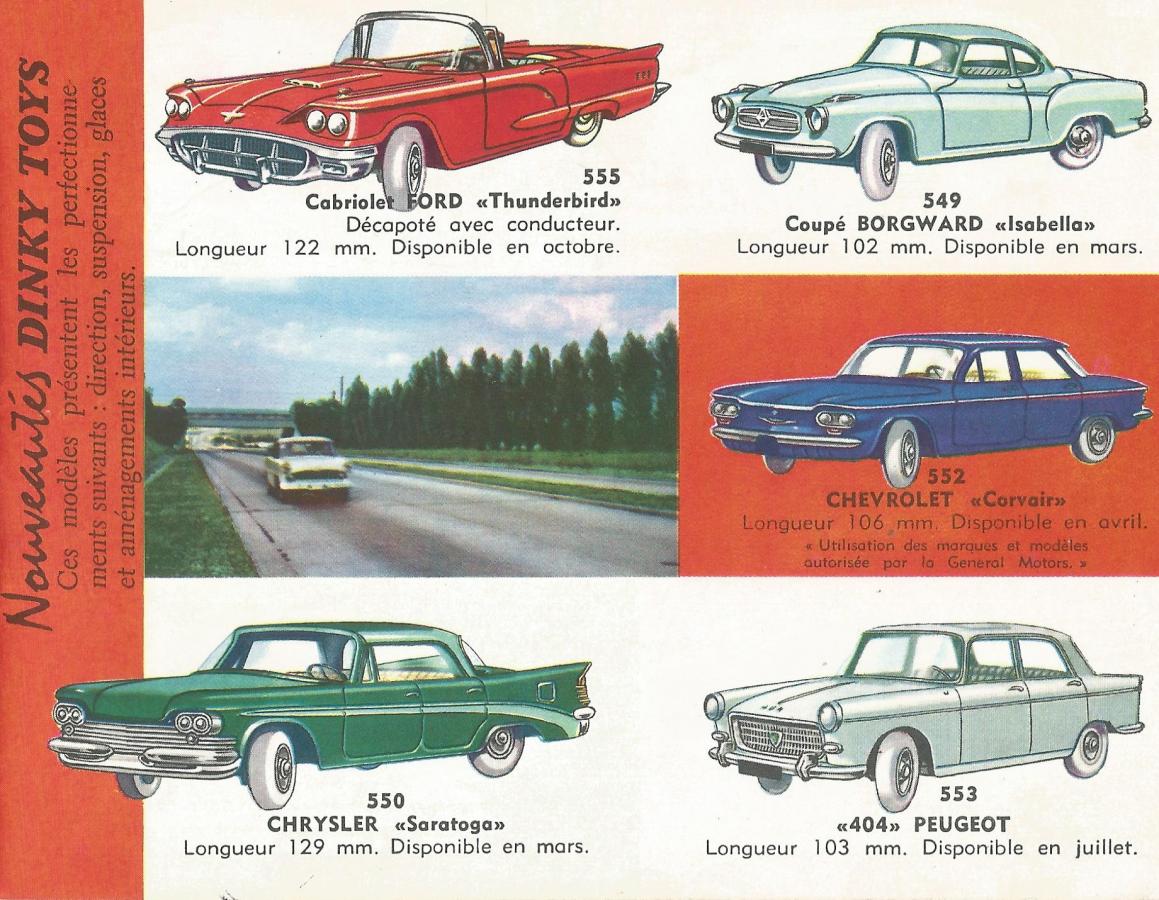
3) In the Meccano catalogue France 1961-1962 he appeared in the colour pink with white flash. This is one of the original colours in which he was issued. It is very remarkable that this is the only catalogue in which it was shown in the correct colour.
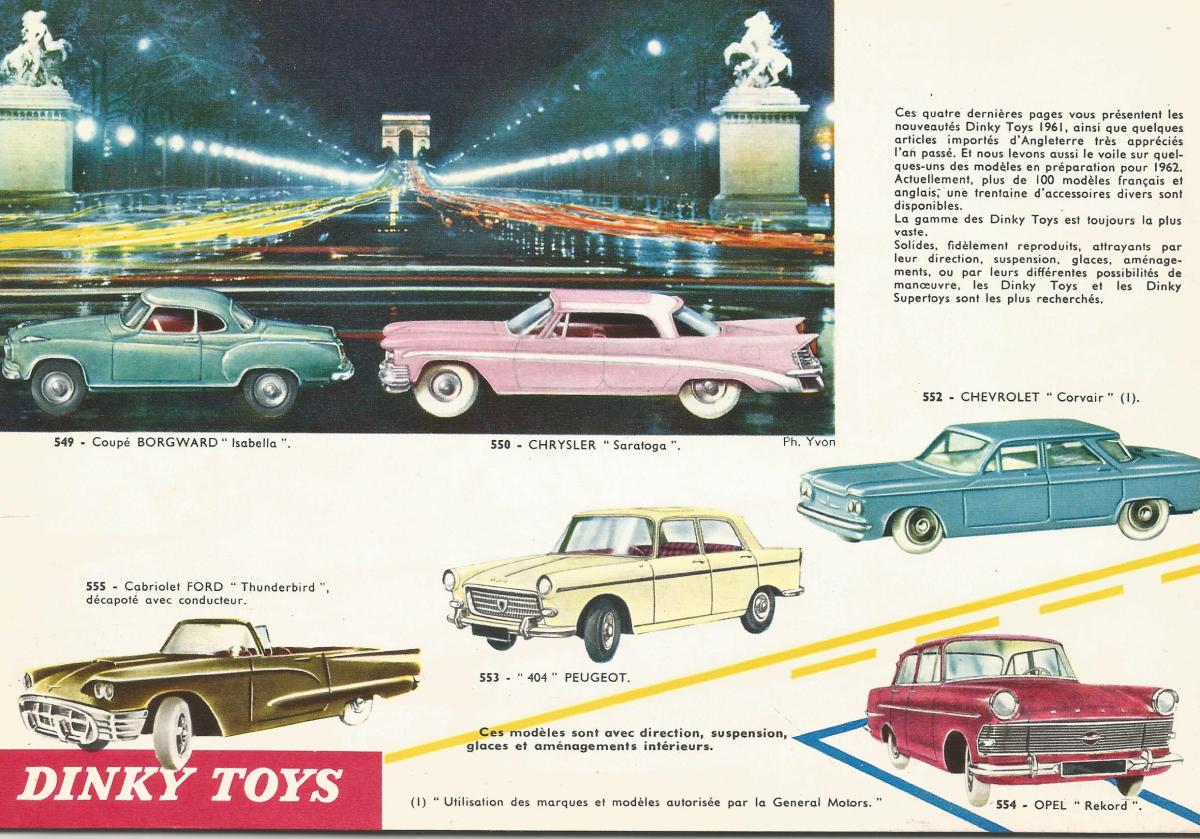
Until the end of production he appeared in all other catalogues in the never been issued colour green.
The 550 Chrysler Saratoga was one of the range of imported French Dinky Toys into the UK in 1962. Announced on a specially issued separate UK leaflet from 10-4-1962 with reduced UK prices, following the withdrawal of Purchase Tax Surcharge.

During the whole production of the Chrysler Saratoga the model is on his yellow box pictured in the never issued colour green.

Fortunately there is an open diamond in the box through which you are able to check the colour of the inside model without open the box. A typical French practical solution for this kind of problems.
The size of the car compared to the other DT USA cars from that period strikes immediately. He is much longer, wider and higher than the others. Jan Werner has already explained this on 26-4-2008 in TMT in scale mathematics, but I'll made this visible with pictures in which I place a French 545 De Soto Diplomat (also of construction year 1959) between 2 French 550 Chrysler Saratoga's (construction year 1959) for comparison.
The 550 is 129 mm long and the 545 is 113 mm long. That differs 16 mm in length.
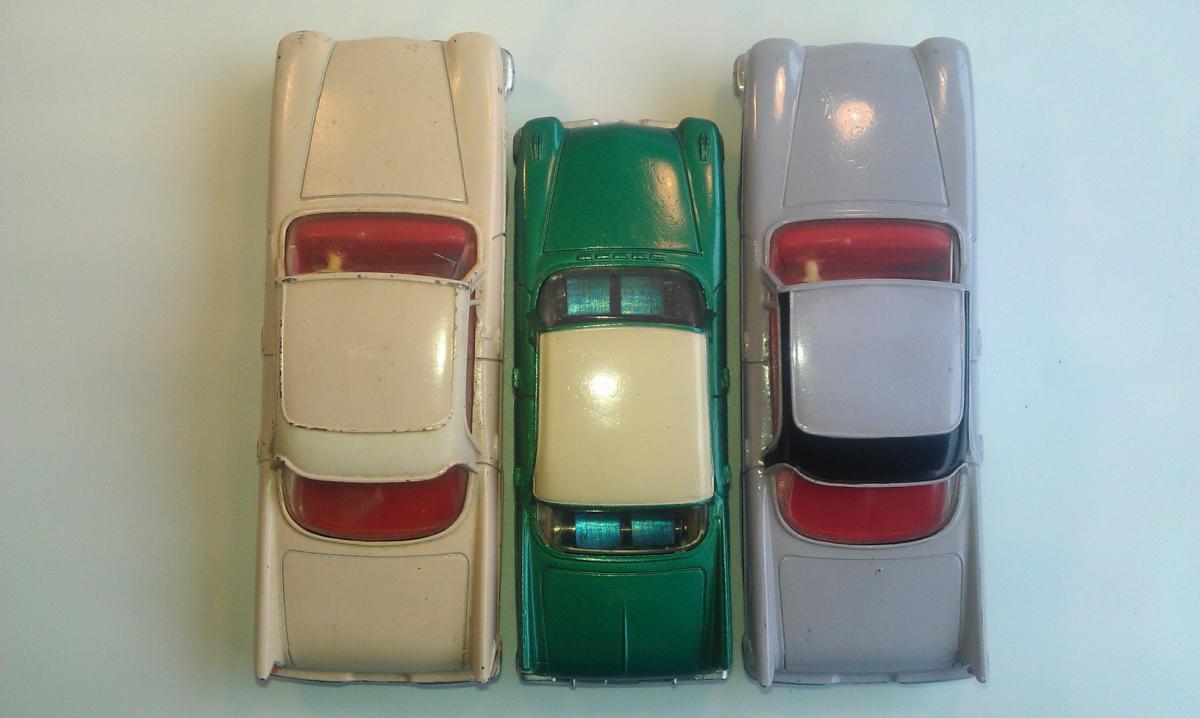
Comparison of Chrysler Saratoga (outside) with De Soto Diplomat (center). Helicopter view.

Comparison of Chrysler Saratoga (outside) with De Soto Diplomat (center). Front view.
Apart from that, this model has a special cast through its upright edges to accentuate the flash. I have not seen this very gross flash accentuation on any other DT, and I find this a very good job from Meccano France. Also this model with a red interior, big ivory steering wheel and large wheels gives the car a "big" look. (Only the colours of the car I think are badly chosen).

Cast upright edges to accentuate the flash

Cast upright edges to accentuate the flash. Note the big tyres!!
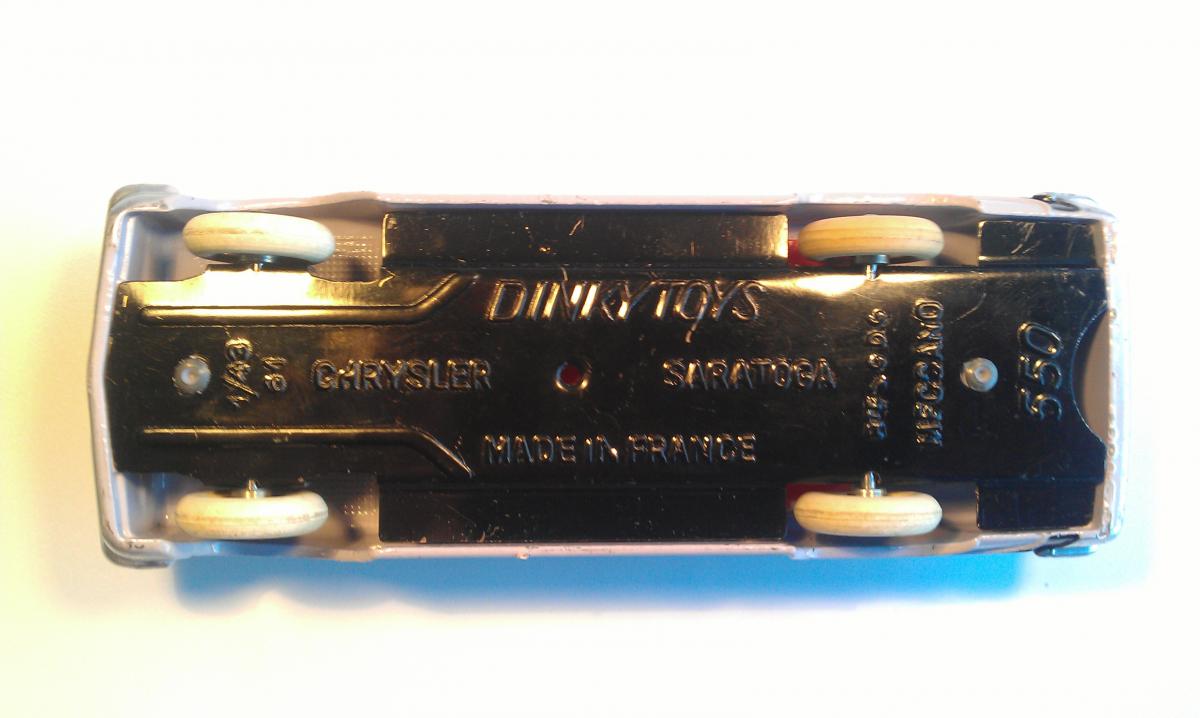
I like to mention here Jacques Dujardin's remark in TMT: On the base plate, the ref. number is stamped in slant numbers which is very un-usual.
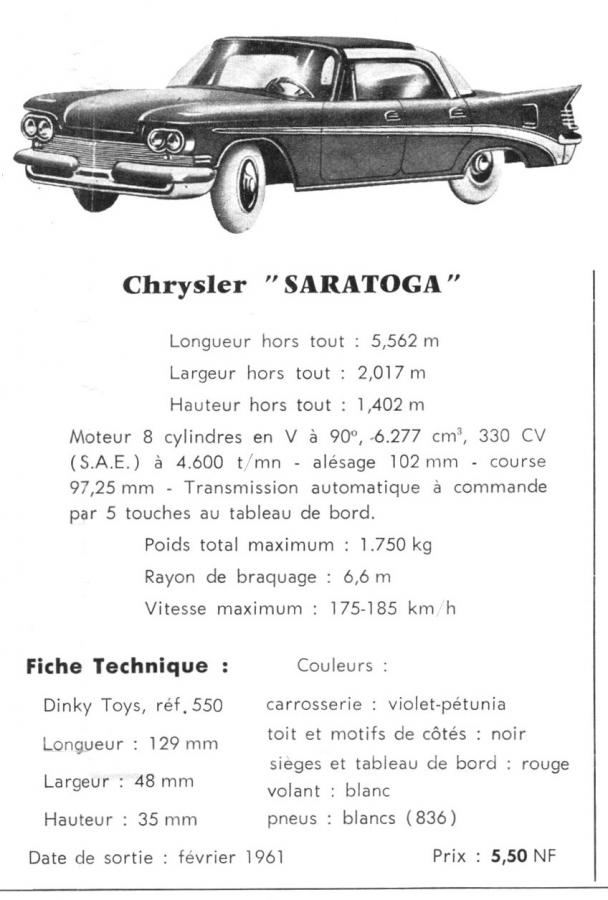
Meccano Magazine France July 1961
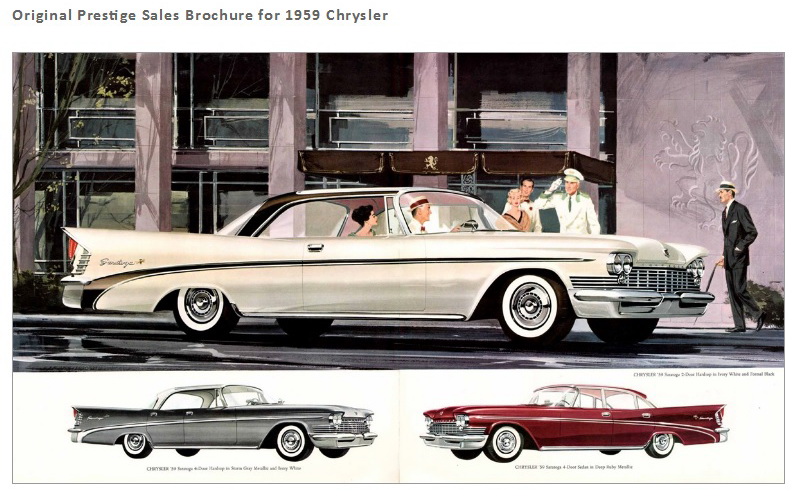
Chrysler Saratoga 1959 Sales Brochure
The model is issued from 1961-1965 with plated concave hubs, smooth or treaded white tyres, windows, spring suspension and fingertip steering in the following colours:
Pale pink with white flash
Deep pink with white flash
Violet with black flash.
Greetings to all members and other interested readers of DTCA forum. Join us.
22-5-2017 Jan Oldenhuis
Hi Jan, a great contribution about this impressive American car!
A lot of the remarkable characteristics have to do with the unusual 1/43 scale. Most other American giants have a scale of 1/48. Even most British saloons have a smaller scale of 1/45. This explains the thick ridges along the flash and the huge tyres. The Ford Thunderbird (FDT555) is somewhere in between. Neither the small 15 mm tyres nor the medium 17/18 mm tyres really match.
I made some new photos demonstrating that the suspension on the rear wheels is so feeble (or the weight is so uncommonly heavy) that it stands lower on its wheels than desired. This annoyed me already when I bought it 55 years ago. My photos demonstrate the difference.
I also made a photo of that rather unuseful remark on the inside side flaps that the model's colour may differ from the picture on the box. Indeed it does, but that is easily seen through the little open diamond in the box's side.
Finally about the colour. I was surprised anyway when I got it so many decades ago, because it differed from the catalogue pictures indeed. But I wasn't aware of the existence of the pink one, which appears to be more common than this one. Sometimes I read an amount twice the pink one for this light purple one.
My example is still in good condition, given that we still played with it - and even the box is very nice, despite frequent packing and unpacking.
Kind regards, Jan W.
Jan-Many thanks for your addition. The back suspension of my 2 Chrysler Saratoga's do also hanging the car downwards.
In Dutch, we than say, "hij is door zijn vering gezakt" ![]() - He has sagged through its suspension. (I hope that I translated it in correct English).
- He has sagged through its suspension. (I hope that I translated it in correct English).
Kind regards,
Jan Oldenhuis
Jan & Jan--
First, a very nice writeup on this model, with lots of history to learn about it. That sure is strange that they showed it so often in colors never used.....interesting and you have to wonder why? And Jan, so nice to see your very original example still in such great conditon....even that box is better than most.
I finally bought one of these a few years ago, partly because I happened to like that era of Chrysler cars, but also I wanted to sample just what these later Dinky Toys had to offer. My main collecting interest runs to about 1959, but the past few years I have strayed a bit into some of the early 1960's offerings, mostly out of curiosity. I am posting a photot mine, mainly to show those large white, lightly treaded tires. I am assuming that those were later than the large white, smooth version. I also like these treaded tires better than their English counterparts from the late 1950's, that have such large treads, very unattractive on automobiles. As a side note, mine does not seem to be suffering the lower rear end sag as much......so far at least!
Best regards, Terry
Terry-Your model looks beautiful and the bottom of the chassis can indeed be seen in a beautiful horizontal line.
Nice to post a picture of this model with treaded tires. I also love more of the treaded tires than the smooth tires. It is prettier to see.
Best regards, Jan Oldenhuis
Ragnar-A very nice picture. Congratulations. You fixed it very well ![]() .
.
Jan Oldenhuis
Hi all, as Terry's example is fitted with the treaded tyres it may be a slightly later production. If so, the apparently nice horizontal position of his model may indicate that the factory improved the initial weak suspension for this oversized model. Any more evidence for this? Kind regards, Jan
Ragnar-Thank you for your photo of your Saratoga with black treaded tyres.
According to Jean-Michel Roulet (page 130), this model is normaly issued with white tyres of large diameter, first smooth and then with profile. So your black tyres indeed are replacement tyres. But ... take note at a added picture of Jan Werner of TMT with the end flaps of the yellow 550 box. There is stated in the French language that tyres with number 835 or 836 can be used as a replacement for this model.
If you look at my added picture of the French Dinky Toys catalogue 1961-1, tyres of number 835 are black and tyres of number 836 are white. I am not a specialist to conclude if your Saratoga has these 835 black tyres, but you may conclude that your Saratoga with black tyres is a correct combination. Nothing wrong with it.
Kind regards,
26-5-2017 Jan Oldenhuis
The drawings on the boxes and catalogues were often made from the wooden mock-up but the mockup of the Saratoga has not been painted and is still so.
When a new model was to be issued, things had to go fast : getting the mock-up from a subcontractor modelist company, drawings of the casting and base plate, drawing of the die or dies, testing and modification of the die, printing of the boxes and catalogues, casting and assembly of a pilot lot, painting of the pilot lot in various colours, most of them ending in the local dump, choosing the colours of the final models etc.... A lot of work in a minimum time.
This explains why the boxes and catalogues were odered from the printers before the final colours were choosen. These documents were printed with any colour possible.
The diamond hole in the boxes is mainly economical as a single box type can be used what ever the colour of the model. This avoids stocking different boxes according to the colour of the model in the box. It is also economical for the collectors who do not have to search boxes with the correct colour spot.
This post aplies to several models, if you want me to duplicate it to other threads, please ask stating the model and its ref. where you want the post to be duplicated.
Jacques
Thanks, Jacques, for your expert comment! The bare wooden prototype is shown indeed, by Roulet in the 2nd edition, page 210 below, fig. 866. And, to be more precise, a green colour trial prototype, with grey detailing, conform the well-known drawing on box and in catalogues, is preserved as well, shown by Roulet on page 210, fig. 867.
I (we) appreciate very much that you are online again! Kind regards, Jan
Hello Jan W.
Thank you for your kind words.
There are two better pictures (3/4 front and 3/4 rear 700 pixels wide) of the wooden mock-up on the Dinky Toys encyclopædia. The green and the silver models are also there.
All the best.
Jacques.
Richard
Well noticed! Interesting to see that the Saratoga received this amendment due to an ejecting problem that was encountered. Is the same modification carried out with the interior of the roof and boot/trunk also?
I have never added the Saratoga to my French collection but looking at some of the images above, the hubs are very similar to those used with the Mercedes Benz 186, Holden 196, and other Liverpool models of that vintage, or am I mistaken.
Cheers
Bruce H. (150)
20172905/1113/1037
Bruce
This modification is due to an injection problem not ejection.
A die has to be polished very well, with wear of the die the polishing goes and the metal does not flow so well leaving spiral marks on large surfaces. Castings with such marks are recycled and cost time and energy. When too many models are cast with such marks, cross hatch is added to the mould or the mould is scraped.
All the best.
Jacques (100)
Dear Jacques, this is one of your familiar specialist technical kind of answers that have been wanting here for such a long time!
Thank you, and kind regards, Jan
Richard
After reading the Post from Jacques, Post #16 above, and the comment from Jan W. my apologies for dabbling in the area of technical expertise. I am reminded of what Jaques wrote in the Interior Cross Hatching Topic that can be found in the Dinky Toys Technical Discussions forum. Unfortunately what Jacques wrote then was severely cut during or before the transfer from the old website to the new which provided details on adjustments such as cross hatching, checkering or some other variation.
This what Jacques wrote on 17 September 2014:
I have answered this question several times on various forums.
"checkering" or "cross hatching"is applied to large flat surfaces to facilitate the flow of metal in the die and reduce the weight of the toy but also to save on the metal. If you save 10 gr. on 1 000 000 models you have saved 1 ton of zamac.
The main reason is that large flat surfaces such as car roofs, tippers etc…
For the information of our readers, the above is all that was transferred from the old website to the new website. It appeared to me last year, that nobody had taken the time to examine that Topic and complete the comments, so 19 months later I conducted my own investigation, as I did with many of my own Posts as well as those from other authors that were incomplete and subsequently the following was graciously provided by Al Keeling that completes what Jacques had originally written:
Posted by me on 4 April 2016
which follows from - The main reason is that large flat surfaces such as car roofs, tippers etc,
are kept thin and the metal does not fill the die completely or makes a turbulence leaving a nasty pattern or depression on the casting which has to be rejected and re-cast. The dies are highly polished when new, this eases the flow of metal but with aging, the surfaces are not so smooth and this slows the flow of metal. This is the reason why the cross hatching is usually not found on early models.
Some models such as the 24D Plymouth Belvedere, 25C Citroën H type van or 32E Berliet fire engine have also had flow channels added to the ceilings. I agree that this technique started in 1956 or maybe 1955 with the 24N Traction. It would be interesting to make a list of the models with cross hatching to know when this stopped. Did any of the models with windows have it?
In future I will refer questions of this nature to the Dinky Toys Technical Discussions and to the Interior Cross Hatching topic.
However, it is to be noted that my last paragraph Post #15 has NOT been answered with the sole comments being directed to the casting variation. It would be nice if a specialist or someone else can provide an answer.
Bruce H. (150)
20173005/1114/1425
Bruce,
I supose that te spun concave wheel hubs were made from the same drawing in Bobigny and Liverpool. They may have been subcontracted.
Jacques (100)
Richard,
The paint manufacturer was not very good.
... and probably that the buyer in Meccano received nice gift for Christmas !![]()
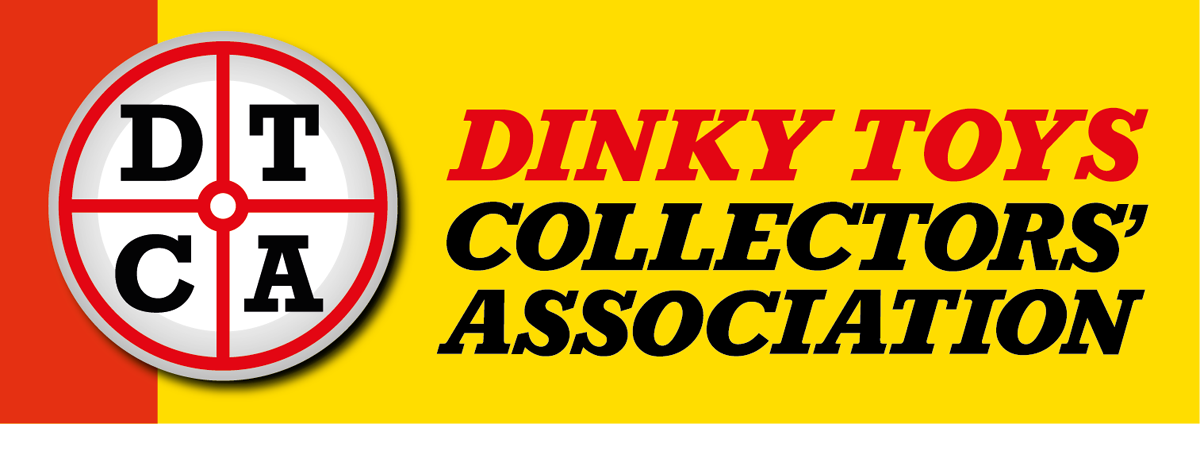



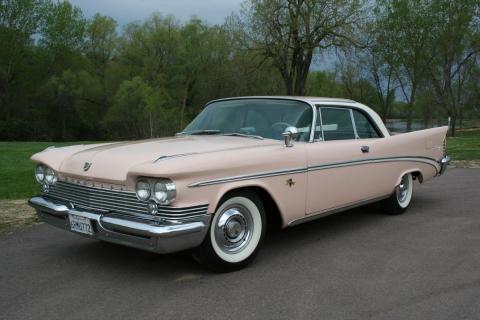

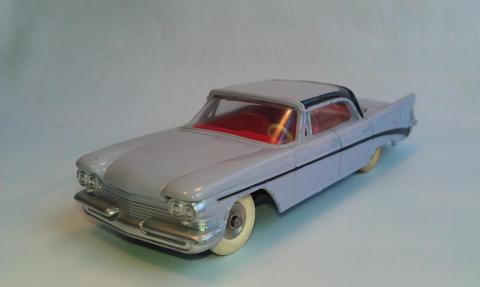
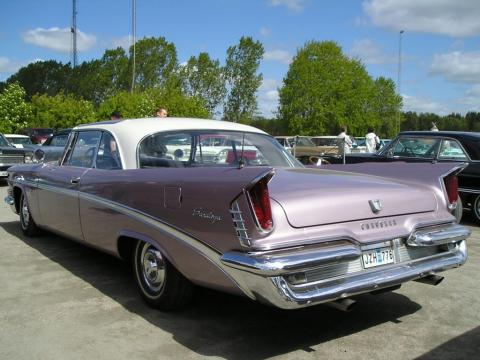

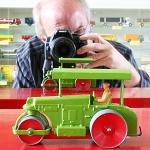

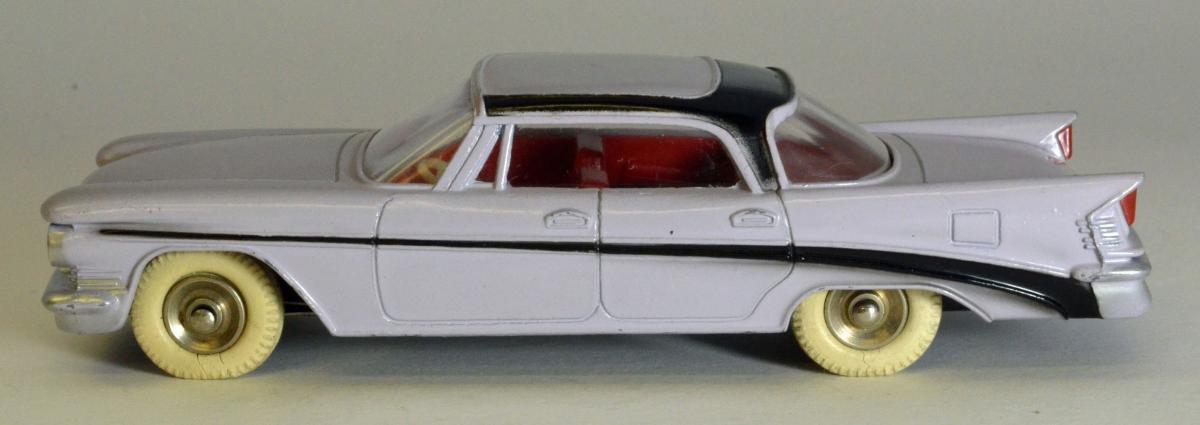
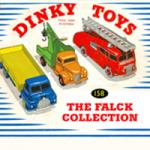


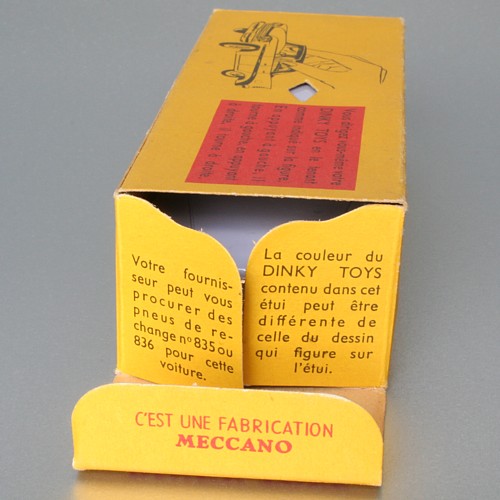
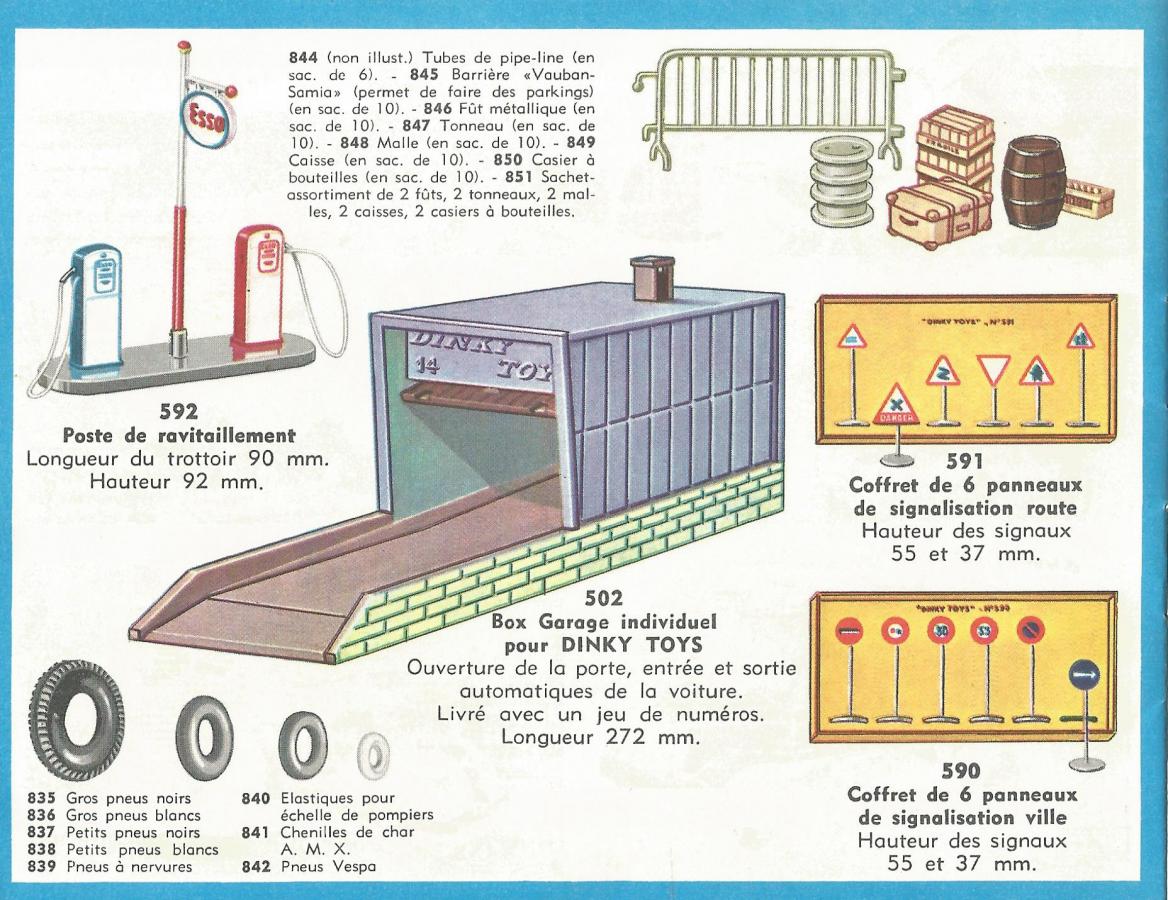

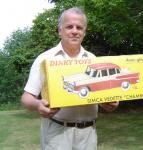
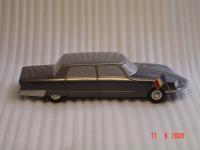


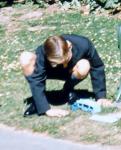


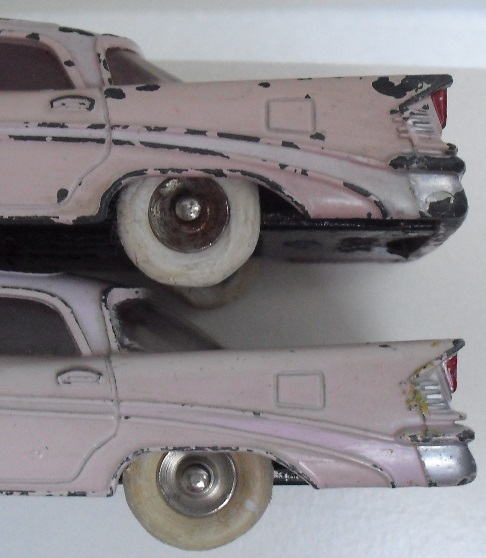


-073 Land Rover, Horse Box and Horse (1960-67)
DTCAwebsite upgrade 2023
DTCAwebsite upgrade 2023
-105c and 383 4-Wheel Hand Truck (1949-1958)
-105c and 383 4-Wheel Hand Truck (1949-1958)
DTCAwebsite upgrade 2023
DTCAwebsite upgrade 2023
DTCAwebsite upgrade 2023
DTCAwebsite upgrade 2023
DTCAwebsite upgrade 2023
DTCAwebsite upgrade 2023
DTCAwebsite upgrade 2023
DTCAwebsite upgrade 2023
DTCAwebsite upgrade 2023
DTCAwebsite upgrade 2023
DTCAwebsite upgrade 2023
DTCAwebsite upgrade 2023
DTCAwebsite upgrade 2023
--22c Motor Truck (1933-50)
--22c Motor Truck (1933-50)
DTCAwebsite upgrade 2023
DTCAwebsite upgrade 2023
Trailer Caravans
Trailer Caravans
DTCAwebsite upgrade 2023
DTCAwebsite upgrade 2023
DTCAwebsite upgrade 2023
DTCAwebsite upgrade 2023
Trailer Caravans
Trailer Caravans
-138 Hillman Imp (1963-73)
-537 Renault 16 TL
-189 Triumph Herald Saloon (1959-64)
-255 Mersey Tunnel Police Van (1955-61)
DTCAwebsite upgrade 2023